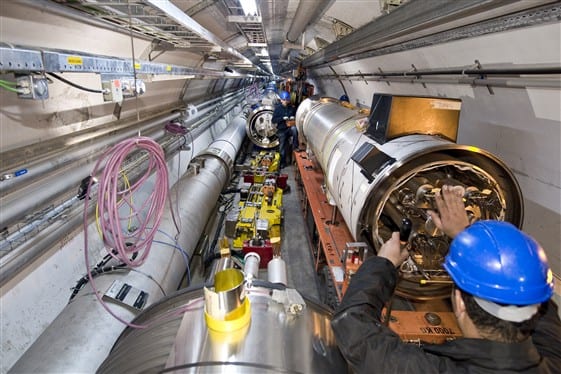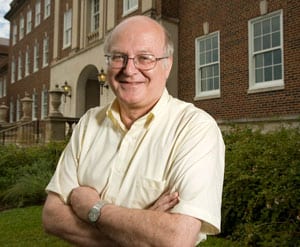After a huge success in first testing, followed by a very public meltdown last September, the Large Hadron Collider may be ready for action again as early as June.
But before the science can proceed, the world’s scientists must come to terms with the complex organism they have created, says one project manager.
“We will have to understand the detector first,” says Ryszard Stroynowski, chair and professor of physics at SMU.
Stroynowski is U.S. Coordinator for the Liquid Argon Calorimeter, the literal and experimental heart of ATLAS, the largest particle detector in the LHC array.
Pictured right: Work progressing in the LHC tunnel.
Photo courtesy of CERN.
The first priority for operation of the ATLAS detector is “to get all those billions of elements to work together in synch again,” Stroynowski says. “We want to see during the summer whether the circulating beam will induce any noise in the system.”
Stroynowski leads an SMU delegation that includes Fredrick Olness, professor of physics, and Robert Kehoe and Jingbo Ye, assistant professors of physics, all in Dedman College. Kehoe is currently at CERN for his research.
The SMU team is focusing on three projects in parallel:
- improvements of the graphic and software interfaces for control and monitoring of the detector and of the quality of its data
- preparation of the software packages to analyze the data
- design and prototyping of the modifications of the readout electronics that will be needed for future upgrades of the experiment to much higher-intensity beams — a six-year research and development project led by Jingbo Ye in SMU’s Physics Electronics Lab.
The LHC is considered the world’s largest physics experiment. The particle accelerator is a 27-kilometer circular tunnel that lies 100 meters underground near Geneva on the French-Swiss border. It uses a magnetic field to propel high-energy protons into each other.
A mechanical failure in September 2008 damaged 53 of the super-sized magnets that power and focus the accelerator’s beams. The final replacement magnet was lowered into place April 30. Repairs in the tunnel now focus on connecting the magnets together and installing new safety and monitoring systems to prevent similar incidents from happening again.
In addition, the 37 damaged magnets that were replaced by spares will be refurbished to serve as spares themselves. Sixteen magnets sustained only minimal damage and were repaired and reinstalled.
The earlier malfunction has resulted in a frustrating wait — one that has had a “rather demoralizing” effect on the students and postdoctoral fellows whose time at the LHC may come and go during downtime, Stroynowski says. Yet the importance of protecting the vast high-energy array from future trauma can’t be overstated, and “the goal is worth the wait, as the payoff may be enormous,” he says.
Scientists and technicians at the European Organization for Nuclear Research — called by its acronym, CERN — in Geneva have maintained an aggressive rehabilitation schedule. The ATLAS detector itself was closed on May 5, marking an end to checks and re-checks of the electronics, cables and other connections. Repairs to the accelerator’s underground ring are scheduled to be completed at the end of May.
Beams will start in June, initially at a relatively low 450 gigaelectron volts (GeV) per beam to ensure the integrity of the new parts and connections. Scientists will raise the energy over a couple of days to 2 teraelectron volts (TeV) per beam, and finally to the LHC’s target operational level of 5 TeV per beam.
The ATLAS team will start taking shifts in July and expects to have useful data starting in October 2009, Stroynowski says. The LHC will then run continuously for 11 months.
Stroynowski says he doesn’t expect any major discoveries by this time next year, but that he hopes “significant results” will come early in 2011.
The LHC’s proton collisions release even smaller pieces of matter, and the Atlas particle detector helps measure the tracks they leave. The huge, international project is directed at finding the “Higgs boson,” a subatomic “God particle” that physicists believe could help explain the origin of our Universe.
The theory behind the Higgs boson holds that all particles had no mass just after the “Big Bang.” As the Universe cooled and the temperature fell below a critical value, an invisible force field composed of subatomic particles called the “Higgs boson” developed throughout the cosmos. Particles that interact with the field gain mass and particles that never interact have no mass. But the theory remains unproven because no one has ever seen the Higgs boson at work. — Kathleen Tibbetts
SMU has an uplink facility on campus for live TV, radio or online interviews. To speak with Dr. Stroynowski or to book him in the SMU studio, call SMU News & Communications at 214-768-7650 or UT Dallas Office of Media Relations at 972-883-4321.
SMU is a private university in Dallas where nearly 11,000 students benefit from the national opportunities and international reach of SMU’s seven degree-granting schools. For more information see www.smu.edu.
 After a huge success in first testing, followed by a very public meltdown last September, the
After a huge success in first testing, followed by a very public meltdown last September, the 




